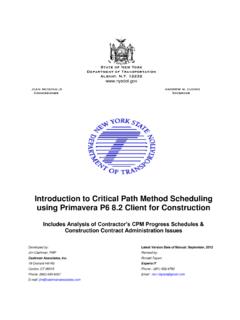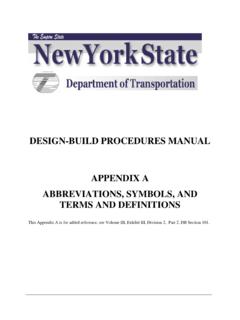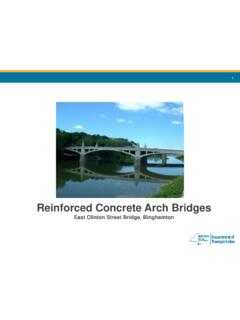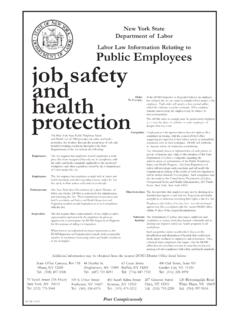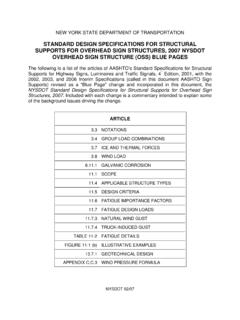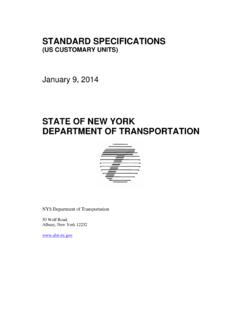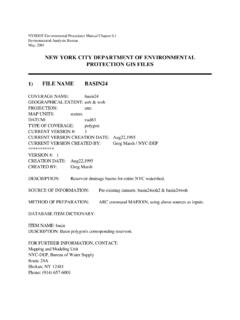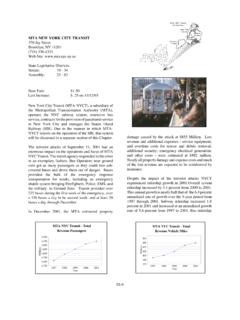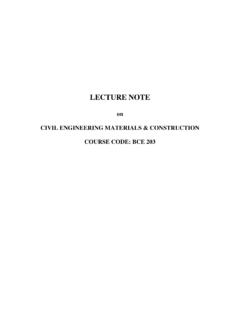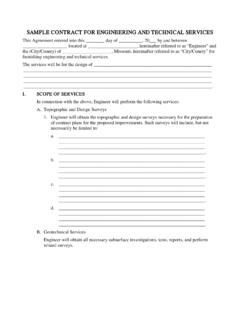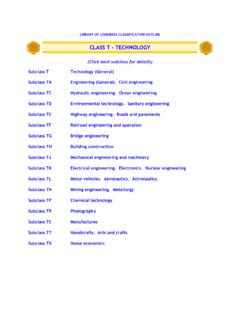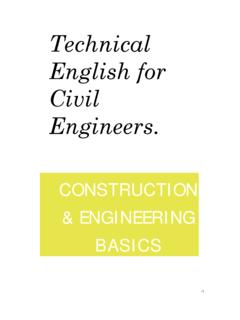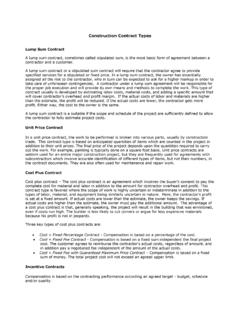Transcription of CHAPTER 6
1 NYSDOT Geot echnical Page 6-1 June 17, 2013 Design Manual GEOTECHNICAL DESIGN MANUAL CHAPTER 6 engineering PROPERTIES OF SOIL AND ROCK NYSDOT Geot echnical Page 6-2 June 17, 2013 Design Manual (Intentionally left blank) Table of Contents NYSDOT Geot echnical Page 6-3 June 17, 2013 Design Manual OVERVIEW .. 6-6 INFLUENCE OF EXISTING AND FUTURE CONDITIONS ON SOIL AND ROCK PROPERTIES .. 6-6 METHODS OF DETERMINING SOIL AND ROCK PROPERTIES .. 6-7 GEOTECHNICAL LABORATORY SERVICES .. 6-7 Type of Laboratory Testing .. 6-8 Quality Control for Laboratory Testing .. 6-12 Developing the Testing Plan.
2 6-13 Laboratory Soil Performance Test Requests .. 6-14 Consolidation Tests .. 6-17 Strength Tests .. 6-17 Relevance of Laboratory Strength Tests to Field Conditions . 6-18 Types of Triaxial Strength Tests .. 6-19 Selection of Final Design Shear Strengths .. 6-21 LABORATORY TESTING FOR THE DETERMINATION OF SOIL INDEX PROPERTIES .. 6-23 Grain Size Analysis .. 6-23 Sieve Analysis .. 6-25 Sieve Analysis of Topsoil .. 6-27 Hydrometer Analysis .. 6-27 Moisture Content .. 6-29 Atterberg Limits .. 6-29 Plastic Limit .. 6-31 Liquid Limit .. 6-31 Plasticity Index .. 6-31 Liquidity Index .. 6-31 6-32 Specific Gravity of Soils.
3 6-32 Organic Content .. 6-33 LABORATORY TESTING FOR THE DETERMINATION OF ROCK INDEX PROPERTIES .. 6-33 Punch-Penetration Index Test .. 6-33 Cerchar Abrasivity Index (CAI) Test .. 6-33 Thin Section Petrographic Analysis .. 6-34 Table of Contents NYSDOT Geot echnical Page 6-4 June 17, 2013 Design Manual LABORATORY TESTING FOR THE DETERMINATION OF SOIL PERFORMANCE PROPERTIES .. 6-34 Strength Tests .. 6-34 Unconfined Compression Test .. 6-35 Triaxial Test .. 6-35 Unconsolidated-Undrained (UU) or Q Test .. 6-35 Consolidated-Undrained (CU) or R Test .. 6-35 Consolidated-Drained (CD) or S Test .. 6-36 Direct Shear.
4 6-36 Consolidation Test .. 6-36 Shrinkage and Swell .. 6-38 Shrinkage .. 6-38 Swell .. 6-39 Permeability .. 6-39 Laboratory Tests .. 6-39 Constant Head Test .. 6-39 Falling Head Test .. 6-39 Flexible Wall Permeability .. 6-40 Particle Analysis .. 6-40 Specific Surface Analysis .. 6-40 LABORATORY TESTING FOR THE DETERMINATION OF ROCK PERFORMANCE PROPERTIES .. 6-42 Resonant Frequency Test .. 6-42 Uniaxial Compressive Strength (UCS) Test .. 6-42 Indirect (Brazilian) Tensile Strength Test .. 6-43 Point Load Test .. 6-43 LABORATORY TESTING FOR THE DETERMINATION OF SOIL LONG-TERM PERMANENCE PROPERTIES .. 6-44 Compaction.
5 6-44 Standard Proctor .. 6-45 Modified Proctor .. 6-48 Relative Density Test .. 6-48 Maximum Index Density .. 6-48 Minimum Index Density .. 6-48 Electro-Chemical Tests .. 6-49 pH Testing .. 6-49 Resistivity 6-49 Chloride Testing .. 6-49 Sulfate Testing .. 6-50 Sulfide Testing .. 6-50 Table of Contents NYSDOT Geot echnical Page 6-5 June 17, 2013 Design Manual Durability .. 6-50 Magnesium Sulfate Soundness Test .. 6-50 LABORATORY TESTING SUMMARY .. 6-51 Undisturbed Data Summary .. 6-52 The SHANSEP Procedure .. 6-56 engineering CHARACTERISTICS OF SOILS .. 6-60 Organic Soils .. 6-61 Compacted Soils.
6 6-63 Permeability .. 6-69 Drainage Capabilities of Soils .. 6-72 engineering CHARACTERISTICS OF ROCK .. 6-73 Unit Weight of Rock .. 6-74 Average Weight of Various Materials Blasted .. 6-76 Description of Rock Quality .. 6-77 Recommended Allowable Bearing Pressure for Footings on Rock .. 6-77 FINAL SELECTION OF DESIGN VALUES .. 6-78 Overview .. 6-78 Data Reliability and Variability .. 6-79 Final Property Selection .. 6-80 Development of the Subsurface Profile .. 6-81 REFERENCES .. 6-84 CHAPTER 6 engineering Properties of Soil and Rock NYSDOT Geot echnical Page 6-6 June 17, 2013 Design Manual OVERVIEW The purpose of this CHAPTER is to identify, either by reference or explicitly herein, appropriate methods of soil and rock property assessment, and how to use that soil and rock property data to establish the final soil and rock parameters to be used for geotechnical design.
7 The final properties to be used for design should be based on the results from the field investigation, the field testing, and the laboratory testing, used separately or in conjunction. Site performance data should also be used if available to help determine the final geotechnical properties for design. The Department Geotechnical Engineer s responsibility is to determine which parameters are critical to the design of the project and then determine those parameters to an acceptable level of accuracy. See NYSDOT GDM CHAPTER 2, and the individual chapters that cover each geotechnical design subject area, for further information on what information to obtain and how to plan for obtaining that information.
8 The focus of geotechnical design property assessment and final selection shall be on the individual geologic strata identified at the project site. A geologic stratum is characterized as having the same geologic depositional history and stress history, and generally has similarities throughout the stratum in terms of density, source material, stress history, and hydrogeology. It should be recognized that the properties of a given geologic stratum at a project site are likely to vary significantly from point to point within the stratum. In some cases, a measured property value may be closer in magnitude to the measured property value in an adjacent geologic stratum than to the measured properties at another point within the same stratum.
9 However, soil and rock properties for design should not be averaged across multiple strata. It should also be recognized that some properties ( , undrained shear strength in normally consolidated clays) may vary as a predictable function of a stratum dimension ( , depth below the top of the stratum). Where the property within the stratum varies in this manner, the design parameters should be developed taking this variation into account, which may result in multiple values of the property within the stratum as a function of a stratum dimension such as depth. INFLUENCE OF EXISTING AND FUTURE CONDITIONS ON SOIL AND ROCK PROPERTIES Many soil properties used for design are not intrinsic to the soil type, but vary depending on conditions.
10 In-situ stresses, the presence of water, rate and direction of loading can all affect the behavior of soils. Prior to evaluating the properties of a given soil, it is important to determine the existing conditions as well as how conditions may change over the life of the project. Future construction such as new embankments may place new surcharge loads on the soil profile or the groundwater table could be raised or lowered. Often it is necessary to determine how subsurface conditions or even the materials themselves will change over the design life of the project. Normally consolidated clays can gain strength with increases in effective stress and overconsolidated clays may lose strength with time when exposed in cuts.
